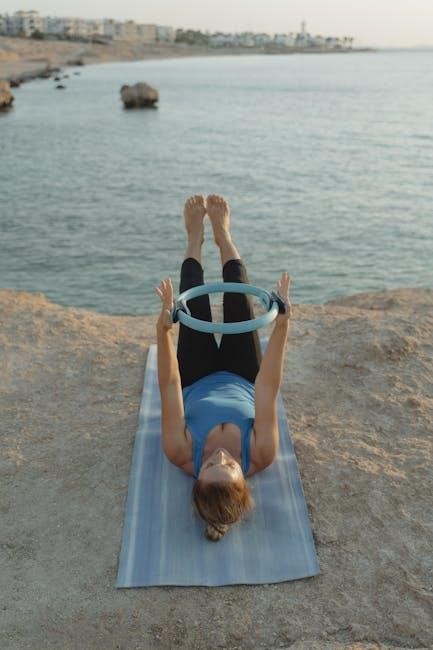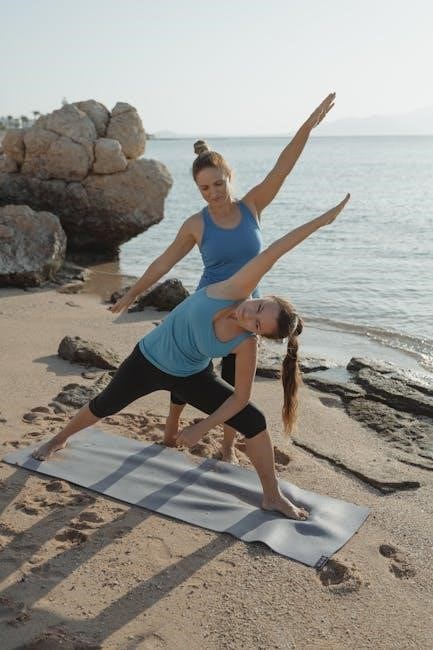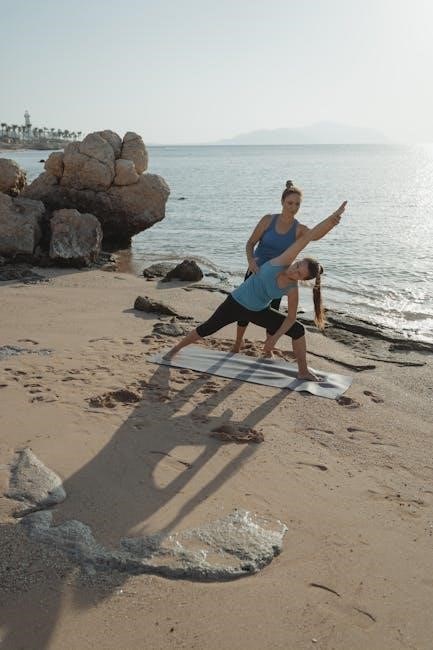pnf stretching exercises pdf
PNF stretching enhances flexibility through neuromuscular techniques. Developed for rehabilitation, it’s now widely used in sports and fitness. Popular PNF stretching exercises are detailed in downloadable PDF guides.
1.1 What is PNF Stretching?
PNF stretching, or Proprioceptive Neuromuscular Facilitation, is a technique combining passive stretching and muscle contractions to improve flexibility and neuromuscular function. It involves an initial stretch followed by a voluntary muscle contraction and subsequent relaxation. This method enhances the nervous system’s role in muscle lengthening, making it highly effective for rehabilitation and sports performance. PNF stretching exercises are detailed in various downloadable PDF guides, which provide structured routines and examples for different muscle groups. These guides often include illustrations and step-by-step instructions, making them accessible for both professionals and individuals. The technique is widely recognized for its ability to increase range of motion, reduce muscle tension, and improve overall physical performance. Regular practice can also prevent injuries and aid in recovery.
1.2 History and Development of PNF Techniques
PNF stretching originated in the 1940s through the work of physical therapists Herman Kabat, Margaret Knott, and Dorothy Voss. Initially developed to aid patients with neurological conditions like spasticity, PNF techniques focused on enhancing neuromuscular coordination and flexibility. The methods were refined over decades, incorporating principles of proprioception and muscle contraction to improve rehabilitation outcomes. By the 1960s, PNF stretching gained popularity in sports, adapting its techniques to enhance athletic performance. Today, it is widely used in both clinical and sports settings, with detailed exercise routines available in downloadable PDF guides, making it accessible for therapists, athletes, and fitness enthusiasts alike.
1.3 Importance of PNF Stretching in Rehabilitation and Sports
PNF stretching is vital in rehabilitation for improving mobility and reducing spasticity in individuals with injuries or neurological conditions. In sports, it enhances performance by boosting flexibility, strength, and coordination. Its neuromuscular focus aids in injury prevention and recovery. Many physical therapists and trainers use PNF techniques to tailor exercises for specific needs, ensuring effective rehabilitation and athletic development; Detailed PNF stretching exercises are often outlined in downloadable PDF guides, providing structured routines for both clinical and sports settings. These resources emphasize proper techniques to maximize benefits and safety, making PNF a cornerstone in modern rehabilitation and sports training programs.

Core PNF Stretching Techniques
Core PNF techniques include hold-relax, contract-relax, and hold-relax with opposing muscle contraction. These methods enhance flexibility by combining muscle contractions with stretches, as detailed in PDF guides.
2.1 Hold-Relax Technique
The Hold-Relax technique is a foundational PNF stretching method that combines passive stretching with isometric contractions. It involves passively stretching a target muscle, then contracting it isometrically, followed by relaxation. This sequence helps reduce muscle tone, improve flexibility, and enhance neuromuscular control. The technique is particularly effective for addressing tight muscles and joint mobility limitations. Detailed instructions and variations of the Hold-Relax method can be found in PNF stretching exercise PDF guides, which often include step-by-step visuals and progression tips for various muscle groups. This technique is widely used in both clinical and sports settings to promote recovery and performance. Regular practice can lead to significant improvements in range of motion and muscle balance.

2.2 Contract-Relax Technique
The Contract-Relax technique involves actively contracting the target muscle isometrically, then relaxing it to allow for a deeper stretch. This method leverages the body’s neuromuscular response to improve flexibility. After contracting the muscle for 5-10 seconds, resistance is applied to enhance the effect. A brief hold of the stretch follows relaxation, maximizing range of motion. This technique is particularly effective for reducing muscle tension and enhancing joint mobility. It is widely used in both therapeutic and sports settings, as detailed in PNF stretching exercises PDF guides, to address specific muscle groups and improve overall flexibility. Regular practice can lead to significant improvements in movement and posture.
2.3 Hold-Relax with Opposing Muscle Contraction
This advanced PNF technique combines contraction of the opposing muscle group with a passive stretch. It involves contracting the opposing muscle to inhibit spasm in the target muscle, enhancing flexibility. The process begins with a passive stretch, followed by an isometric contraction of the opposing muscle, and ends with relaxation. This method improves neuromuscular coordination and range of motion. It is particularly effective for athletes and individuals with tight muscles, as it promotes deeper stretches and reduces muscle resistance. Detailed instructions for this technique are often included in PNF stretching exercise PDF guides, making it accessible for both therapists and self-practitioners to implement effectively.

Benefits of PNF Stretching Exercises
PNF stretching improves flexibility, reduces muscle soreness, and enhances recovery. It aids in injury prevention, boosts neuromuscular coordination, and supports overall physical performance in sports and rehabilitation settings.
3.1 Improved Flexibility and Range of Motion
PNF stretching significantly enhances flexibility by targeting neuromuscular connections, allowing for deeper stretches and improved joint mobility. This method reduces muscle tension and increases range of motion, essential for both rehabilitation and sports performance. By incorporating techniques like hold-relax and contract-relax, PNF stretching ensures sustained flexibility gains. Regular practice promotes better movement efficiency and reduces stiffness, making it ideal for athletes and individuals seeking enhanced physical mobility. Available PDF guides provide structured routines to maximize these benefits, ensuring progressive and safe improvement in flexibility.
- Enhances joint mobility
- Reduces muscle stiffness
- Improves overall movement efficiency
3.2 Enhanced Muscle Strength and Neuromuscular Coordination
PNF stretching not only improves flexibility but also enhances muscle strength and neuromuscular coordination. Techniques like hold-relax and contract-relax involve muscle contractions that activate the neuromuscular system, leading to stronger muscles and better coordination. These exercises are particularly effective in rehabilitation and sports training, as they target specific muscle groups to build strength and improve movement efficiency. By engaging the nervous system, PNF stretching promotes balanced muscle development, reducing the risk of injury and enhancing overall physical performance. PDF guides provide detailed routines and exercises that individuals can follow to incorporate PNF stretching into their fitness or rehabilitation regimens, ensuring a comprehensive approach to muscle development and neuromuscular function;
3.3 Injury Prevention and Recovery
PNF stretching plays a crucial role in injury prevention by improving flexibility and muscle balance. It reduces muscle soreness post-workout and enhances recovery. By targeting specific muscle groups, PNF techniques help restore proper movement patterns, reducing the risk of overuse injuries. In rehabilitation settings, PNF stretching is used to promote tissue repair and strengthen injured areas. Regular practice can also improve joint stability, lowering the likelihood of future injuries. Additionally, PNF exercises are often recommended for athletes to maintain optimal muscle function and reduce recovery time between training sessions. Incorporating PNF stretching into a fitness routine can significantly enhance overall resilience and post-injury rehabilitation. PDF guides provide structured routines for safe and effective practice.

Applications of PNF Stretching
PNF stretching is widely applied in physical therapy, sports training, and general fitness. It enhances flexibility and strength, with detailed routines available in downloadable PDF guides.
4.1 Use in Physical Therapy and Rehabilitation
PNF stretching is widely used in physical therapy to aid recovery from injuries and surgeries. It helps improve flexibility, strength, and neuromuscular coordination. Therapists often use PNF techniques to address spasticity, muscle imbalances, and limited range of motion. These exercises are particularly effective for patients with neurological conditions, such as stroke or cerebral palsy, as they promote functional movement patterns. PDF guides are commonly utilized to provide structured routines for rehabilitation, ensuring consistency and progression. By incorporating PNF stretching, physical therapists can enhance recovery outcomes, reduce muscle tension, and prevent future injuries, making it a cornerstone of modern rehabilitation practices.
4.2 Role in Sports Training and Performance Enhancement
PNF stretching plays a vital role in sports training by enhancing flexibility, strength, and neuromuscular coordination. Athletes use these techniques to improve range of motion, reduce muscle stiffness, and optimize performance. The hold-relax and contract-relax methods are particularly effective for increasing power and speed. PNF exercises are often integrated into training programs to prevent injuries and accelerate recovery. Coaches and athletes can access detailed PNF stretching exercises through downloadable PDF guides, which provide structured routines tailored to specific sports demands. These resources emphasize proper technique to maximize benefits and minimize injury risks, making PNF a cornerstone in modern athletic development and performance enhancement strategies.
4.3 Application for General Fitness and Well-being
PNF stretching is a valuable addition to general fitness routines, enhancing flexibility and overall well-being. It helps improve range of motion, reducing muscle tension and preventing injuries. Regular PNF exercises promote better posture and balance, contributing to daily activities. Many find PNF stretching beneficial for maintaining mobility as they age. PDF guides offer structured routines, making it accessible for individuals to incorporate PNF into their fitness regimens. These exercises are adaptable to all fitness levels, ensuring everyone can benefit. By integrating PNF stretching, individuals can enhance their physical fitness and enjoy a healthier lifestyle. Its versatility makes it a popular choice for those seeking comprehensive wellness.

Creating a PNF Stretching Routine
A well-structured PNF stretching routine begins with assessment and goal setting. Include warm-up exercises, core stretches, and progressions. Conclude with a cool-down for optimal recovery. Downloadable PDF guides provide detailed routines and plans.
5.1 Assessment and Goal Setting
Assessment and goal setting are crucial for creating an effective PNF stretching routine. Professionals use PDF guides to evaluate flexibility, strength, and movement limitations. These resources help identify specific muscle groups needing attention. By setting clear, achievable goals, individuals can focus on improving range of motion, reducing stiffness, or enhancing athletic performance. PNF stretching exercises are tailored to address these objectives, ensuring a personalized approach. Regular assessments track progress, allowing adjustments to the routine; This structured method ensures that the stretching program remains aligned with the individual’s needs, whether for rehabilitation, sports performance, or general well-being. Detailed PDF guides provide step-by-step instructions to support this process effectively.
5.2 Warm-Up and Preparation
A proper warm-up is essential before starting a PNF stretching routine. It prepares the muscles and nervous system for the exercises ahead, reducing the risk of injury and enhancing effectiveness. Begin with light cardio, such as jogging or cycling, to increase blood flow and warm up the muscles. Dynamic stretching, like arm circles or leg swings, can further activate the target areas. Additionally, incorporating isometric contractions or gentle mobilizations can improve neuromuscular coordination. A well-structured warm-up ensures optimal preparation for PNF techniques, making the stretching process safer and more productive. Detailed warm-up routines can be found in PNF stretching exercise PDF guides, providing a comprehensive approach to preparation.
5.3 Core Exercises and Progressions
Core PNF exercises focus on major muscle groups, such as hamstrings, quadriceps, and hip flexors. Techniques include hold-relax, contract-relax, and opposing muscle contractions. Progressions involve increasing stretch duration or resistance. Advanced routines incorporate dynamic movements to enhance functional mobility. Many PNF stretching exercises are detailed in downloadable PDF guides, offering structured routines for different fitness levels. These guides often include visual aids and step-by-step instructions, making them accessible for both therapists and individuals. Progressions are tailored to improve flexibility, strength, and coordination progressively. Regular practice ensures sustained improvements in range of motion and overall muscle balance. PDF resources provide comprehensive plans for creating personalized PNF exercise programs.
5.4 Cool-Down and Maintenance
A proper cool-down after PNF stretching is essential to gradually return the body to a resting state. Gentle activities like static stretching or deep breathing can help reduce muscle tension and promote relaxation. Maintaining flexibility and strength requires consistent practice, with routines tailored to individual goals. Incorporating PNF techniques into a regular regimen, such as 2-3 times per week, ensures long-term benefits. Hydration and proper nutrition are also crucial for muscle recovery. Monitoring progress and adjusting routines as needed helps sustain improvements in flexibility and strength. Combining PNF exercises with other modalities enhances overall well-being and maintains the body’s responsiveness to stretching.

Safety and Precautions
Consult professionals before starting PNF stretching. Avoid techniques with acute injuries or chronic conditions. Proper form and moderate intensity are crucial to prevent muscle strain or injury.
6.1 Contraindications for PNF Stretching
PNF stretching is not suitable for everyone. Individuals with acute injuries, fractures, or severe inflammation should avoid it. Those with osteoporosis or joint instability are also at risk. Additionally, people with certain cardiovascular conditions or severe musculoskeletal limitations may need to avoid PNF techniques. It is contraindicated for individuals with multiple sclerosis or nerve damage, as it may exacerbate symptoms. Pregnant women and those with recent surgeries should consult a professional before practicing PNF. Proper assessment is essential to ensure safety and avoid complications. Always prioritize professional guidance to determine suitability for PNF stretching exercises.
6.2 Precautions for Safe Practice

When practicing PNF stretching, it’s crucial to follow safety guidelines to avoid injury. Always consult a professional, especially for individuals with underlying medical conditions. Avoid stretching during acute inflammation or injury. Use controlled, gentle movements to prevent muscle strain. Warm up before starting any routine. Focus on proper breathing techniques to enhance relaxation and effectiveness. Avoid bouncing or forceful movements, as they can cause tissue damage; Pay attention to pain signals; discomfort should be mild. Use props or assistance when needed. Regular practice and gradual progression are key to achieving benefits safely. Refer to PNF stretching exercises PDF guides for detailed instructions and safety tips.
6.3 Importance of Professional Guidance
Professional guidance is crucial when implementing PNF stretching exercises, especially for those new to the technique. A trained therapist or instructor ensures proper form and safety, reducing injury risks. They tailor routines to individual needs, addressing specific muscle imbalances or rehabilitation goals. Without expert oversight, incorrect application of PNF techniques can lead to ineffective results or harm. Professionals also provide feedback and adjustments, enhancing the effectiveness of each exercise. Resources like PNF stretching exercises PDF guides are valuable, but they should be used under the supervision of a qualified practitioner to maximize benefits and minimize risks. This ensures a safe and structured approach to improving flexibility and strength.

Resources and Further Learning

7;1 Accessing PNF Stretching Exercise PDF Guides
Downloadable PDF guides provide detailed PNF stretching routines and techniques. Online resources like stretching-exercises-guide.com offer free PDF summaries for effective practice and reference.
Numerous online resources offer PNF stretching exercise PDF guides, providing detailed routines and techniques tailored for different fitness levels. These guides, available on various websites and physical therapy platforms, include instructions for methods like hold-relax and contract-relax, along with diagrams to illustrate proper form. The portability of these guides allows users to practice anywhere, making them ideal for individuals seeking to improve flexibility and strength. It’s important to download from reputable sources to ensure the information is accurate and safe. Free options are available, making PNF stretching accessible to everyone aiming to enhance their muscle flexibility and overall well-being through structured exercises.
7.2 Recommended Reading and References
For in-depth understanding, several resources are available. Books like Proprioceptive Neuromuscular Facilitation and Advanced PNF Techniques provide comprehensive insights. Journals such as Journal of Sports Science and Physical Therapy regularly publish studies on PNF stretching. Online guides, including PDF manuals, offer practical routines and exercises. Websites like Stretching-Exercises-Guide and Flexibility Training share detailed protocols. These resources cater to both professionals and individuals, ensuring evidence-based practices. They are essential for designing effective PNF programs tailored to specific needs, whether for rehabilitation, sports, or general fitness. Exploring these references enhances knowledge and application of PNF stretching techniques.
7.3 Online Courses and Tutorials
Online courses and tutorials offer comprehensive training in PNF stretching techniques. These resources provide detailed instruction on exercises, proper form, and safety guidelines. Many courses include downloadable PDF guides, such as the PNF Stretching Exercise PDF, which outlines routines for improving flexibility and strength. Platforms like Udemy and Coursera host tutorials led by certified professionals, covering topics from basic to advanced PNF methods. These courses are ideal for both individuals seeking self-improvement and professionals aiming to integrate PNF into client programs. They often feature video demonstrations, printable worksheets, and progress tracking tools, ensuring a structured learning experience. Enrolling in these courses can enhance understanding and mastery of PNF stretching exercises.
